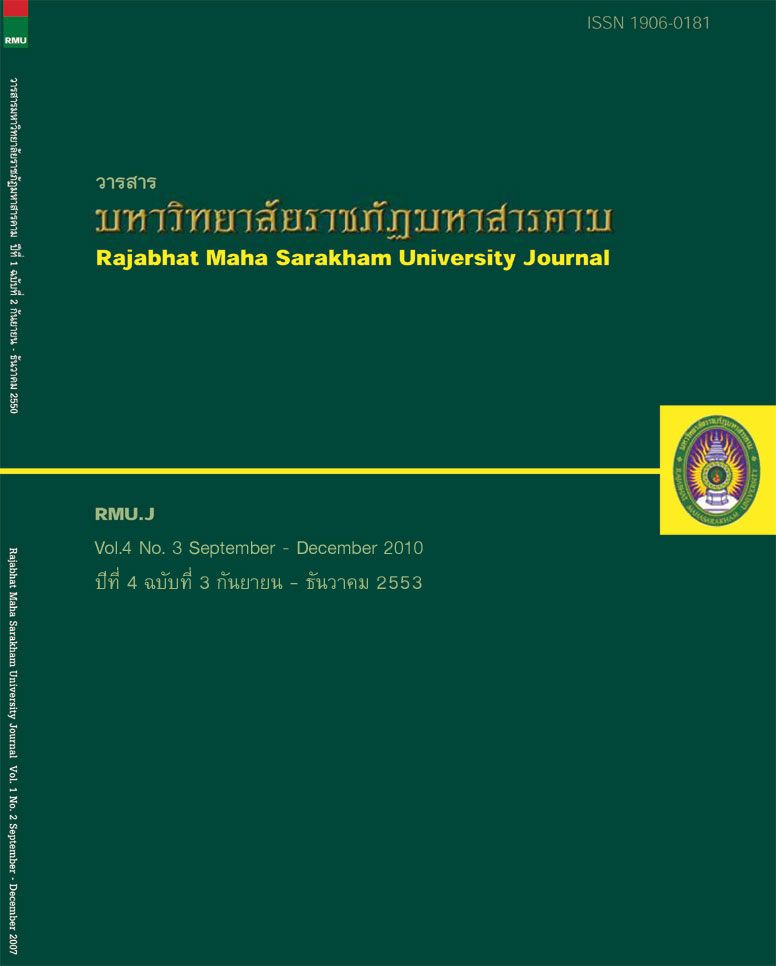การศึกษาคุณภาพน้ำ การมีส่วนร่วมของประชาชนในการรักษาสิ่งแวดล้อม และผลกระทบด้านเศรษฐกิจและสังคมของการเลี้ยงปลาในกระชังในแม่น้ำชี : ศึกษาเฉพาะกรณี จังหวัดมหาสารคาม A Study on Water Quality, People's Participation in Environmental Protection and Socio-Economi
Main Article Content
บทคัดย่อ
การวิจัยครั้งนี้ มีวัตถุประสงค์เพื่อศึกษาคุณภาพน้ำด้านกายภาพ และด้านเคมีของแม่น้ำชี ศึกษาระดับการมีส่วนร่วมของประชาชนในการป้องกันและรักษาแม่น้ำชี และศึกษาการเปลี่ยนแปลงด้านเศรษฐกิจและสังคม ของเกษตรกรที่เลี้ยงปลาในกระชัง การศึกษาด้านคุณภาพน้ำบริเวณที่มีการเลี้ยงปลาในกระชังในแม่น้ำชีช่วงที่ไหลผ่านจังหวัดมหาสารคาม โดยกำหนดพื้นที่ศึกษา จำนวน 6 ตำแหน่ง ตามความยาวของแม่น้ำชี ได้แก่ บ้านกอก บ้านบ่อน้อย อำเภอโกสุมพิสัย บ้านท่าขอนยาง อำเภอกันทรวิชัย บ้านเกิ้ง บ้านม่วง และบ้านท่าตูม อำเภอเมือง จังหวัดมหาสารคาม ในแต่ละตำแหน่งจะทำการเก็บตัวอย่างน้ำจำนวน 3 ครั้ง (ระหว่างเดือนกุมภาพันธ์ ถึง เดือนกรกฎาคม พ.ศ. 2551) ดัชนีคุณภาพน้ำที่ทำการตรวจวัด ได้แก่ อุณหภูมิ ความขุ่น ความโปร่งแสง ความเป็นกรด - ด่าง ปริมาณออกซิเจนที่ละลายในน้ำ ปริมาณออกซิเจนที่ปริมาณจุลินทรีย์ใช้ในการย่อยสลายสารอินทรีย์ ปริมาณไนเตรตในรูปของไนโตรเจน และปริมาณฟอสเฟต
การศึกษาระดับการมีส่วนร่วมของประชาชนในป้องกันและรักษาแม่น้ำชีประกอบด้วย การรับรู้ปัญหาด้านสิ่งแวดล้อม การมีส่วนร่วมของประชาชนในการรักษาแม่น้ำชี ปัญหาและการมีอุปสรรคในการมีส่วนร่วม แนวคิดและข้อเสนอแนะเกี่ยวกับการมีส่วนร่วมของประชาชนในการรักษาแม่น้ำชี กลุ่มตัวอย่างที่ใช้ในการศึกษาคือ ประชาชนที่อาศัยอยู่ริมฝั่งแม่น้ำชี จังหวัดมหาสารคาม จำนวน 376 คน การสุ่มตัวอย่างใช้วิธีสุ่มอย่างแบบง่าย โดยใช้แบบสอบถามเป็นเครื่องมือในการเก็บรวบรวมข้อมูล สถิติที่ใช้ในการวิเคราะห์ข้อมูล ได้แก่ ร้อยละ ค่าเฉลี่ย และส่วนเบี่ยงเบนมาตรฐาน
การศึกษาด้านผลกระทบเศรษฐกิจและสังคมของเกษตรกรที่เลี้ยงปลาในกระชังในแม่น้ำชี จังหวัดมหาสารคาม ประกอบด้วย เนื้อหาเกี่ยวกับข้อมูลด้านเศรษฐกิจ ด้านสังคม การเปลี่ยนแปลงสิ่งแวดล้อมทางกายภาพของชุมชน แนวคิดและข้อเสนอแนะของเกษตรกร กลุ่มตัวอย่างที่ใช้ในการศึกษาครั้งนี้ ได้แก่ เกษตรกรที่เลี้ยงปลาในกระชังในแม่น้ำชีช่วงในจังหวัดมหาสารคาม จำนวน 133 ครัวเรือน โดยใช้แบบสอบถามเป็นเครื่องมือในการเก็บรวบรวมข้อมูลสถิติที่ใช้ในการวิเคราะห์ข้อมูล ได้แก่ ร้อยละ ค่าเฉลี่ย และส่วนเบี่ยงเบนมาตรฐาน ผลการศึกษาพบว่า
ด้านคุณภาพน้ำ
ผลการศึกษาด้านคุณภาพน้ำ พบว่าแต่ละดัชนีคุณภาพน้ำมีค่าเฉลี่ยอยู่ระหว่าง ดังนี้ อุณหภูมิ 28.00-29.66 C ความโปร่งแสง 18.94- 35.11 cm. ความขุ่น 34.29-61.56 NTU ความเป็นกรด - ด่าง 7.32-7.50 ปริมาณออกซิเจนที่ละลายในน้ำ 6.02- 7.90 mg/L ปริมาณออกซิเจนที่จุลินทรีย์ใช้ในการย่อยสลายสารอินทรีย์ 5.20-6.94 mg/L. ปริมาณไนเตรตในรูปไนโตรเจน 0.92-1.56 mg/L. ปริมาณฟอสเฟต 0.25-0.35 mg/L. เมื่อนำมาเทียบกับมาตรฐานคุณภาพน้ำในแหล่งน้ำผิวดิน สามารถจัดให้อยู่ในประเภทที่ 3
ด้านการมีส่วนร่วมของประชาชน
ผลการศึกษาด้านการมีส่วนร่วมของประชาชนในการป้องกันและรักษาแม่น้ำชี สำหรับด้านการรับรู้ปัญหาด้านสิ่งแวดล้อมของแม่น้ำชี พบว่า แหล่งที่ก่อให้เกิดปัญหามลพิษทางน้ำมาจากโรงงานอุตสาหกรรม ประชาชนส่วนใหญ่ไม่ทราบว่ารัฐธรรมนูญแห่งราชอาณาจักรไทยในปี 2550 และแผนพัฒนาเศรษฐกิจและสังคมแห่งชาติฉบับที่ 10 ได้ให้สิทธิของประชาชนเกี่ยวกับการมีส่วนร่วมในการอนุรักษ์แม่น้ำชี สำหรับระดับการมีส่วนร่วมของประชาชนผลการศึกษามีดังนี้ การมีส่วนร่วมในการปรึกษาหารือเกี่ยวกับการรักษาแม่น้ำชี และการมีส่วนร่วมในการประสานงานในการรักษาแม่น้ำชี มีค่าเฉลี่ยโดยรวมอยู่ในระดับน้อย สำหรับการมีส่วนร่วมในการดำเนินการรักษาแม่น้ำชีโดยรวมอยู่ในระดับปานกลาง ส่วนการจัดการรักษาแม่น้ำชีนั้นควรให้ประชาชน องค์การบริหารส่วนท้องถิ่น หน่วยงานภาครัฐ เข้ามามีส่วนร่วมในการบริหารจัดการ การใช้ประโยชน์จากแม่น้ำชีอย่างยั่งยืน
ด้านผลกระทบเศรษฐกิจและสังคม
ำหรับการแก้ไขปัญหาและอุปสรรคในการรักษาแม่น้ำนตำบล ()ว่ารัฐธรรมนูญแห่งราชอาณาจักรไทยในปี araKham ,esวัฒนธรรมและเพณีดั้งเดิอยู่ำหรับการแก้ไขปัญหาและอุปสรรคในการรักษาแม่น้ำนตำบล ()ว่ารัฐธรรมนูญแห่งราชอาณาจักรไทยในปี araKham ,esวัฒนธรรมและเพณีดั้งเดิอยูผลการศึกษาด้านผลกระทบเศรษฐกิจและสังคม พบว่า การเพาะเลี้ยงปลาในกระชังของเกษตรกร ได้ก่อให้เกิดการเปลี่ยนแปลงทางด้านเศรษฐกิจ กล่าวคือ มีผลทำให้เกษตรกรที่เลี้ยงปลาในกระชังมีรายได้สุทธิลดลง โดยมีค่าใช้จ่ายสูงกว่ารายได้ที่ได้รับ ส่วนการเปลี่ยนแปลงทางด้านสังคมนั้น โดยรวมแล้วเกษตรกรยังคงยึดถือแนวการดำรงชีวิตแบบเดิมยังคงยึดมั่นในวัฒนธรรมและประเพณีดั้งเดิมอยู่ แม้ว่าจะมีบางกิจกรรมที่เคยทำได้ลดน้อยลง เช่น การช่วยเหลือกันแบบลงแขกโดยไม่คิดค่าแรง
ในส่วนของสิ่งแวดล้อมทางกายภาพของชุมชนพบว่าชุมชนส่วนใหญ่ยังคงมีความอุดมสมบูรณ์ของสัตว์ธรรมชาติที่ใช้เป็นอาหาร แต่ก็พบว่ามีการเกิดโรคกับปลาที่เพาะเลี้ยงในกระชัง เมื่อปริมาณน้ำในแม่น้ำชีลดน้อยลงในช่วงฤดูแล้ง
The purposes of this research were to study the water quality in terms of physical and chemical characteristics of the Chi River, participation level of people in environmental protection and the change of socio-economics condition of the fish cage agriculture in the Chi River.
Water Quality of the Chi River was studied focusing on Floating Fish Basket Area in Maha SaraKham. Six sampling sites along the river length passing through Maha Sarakham Province were determined for the study, including Ban Kok, and Ban Bu Noi in Amphur Kosumphisai; Ban Ta Khon Yang in Amphur Kuntarawichai; and Ban Kung, Ban Muong and Ban Tatum in Amphur Muang. At each site, the samples were collected three times (between February to July 2009). Water quality parameters were temperature, transparency, turbidity, pH, DO, BOD, NO3– -N, and PO4–.
People's participation in the protection and conservation of the Chi River was studied according to the perception of environmental problem, people's participation in the protection of the Chi River, problem and obstacle of people's participation, concept and suggestion concerning people's participation in the protection of the Chi River. The research questionnaires were processed by the simple random sampling technique, and the total population of samplings living nearby the Chi River was 376. The data obtained were analyzed by mean, percentage (%) and standard deviation (S.D.).
Socio-economic impacts on the fish cage agricultures in the Chi River Mahan Sarakham Province consisted of economic and social information, the changes of physical environment of the community; and the suggestions by the farmer of the fish cage culture in the Chi River. The research samples were 315 households living permanently in the project area. The instrument used for data collection was the questionnaire. The statistical methods used for data analysis were percentage, mean and standard deviation.
The research results ere as the follows:
Water quality :
The results of physical and chemical water quality in the Chi River at the floating fish basket area reveal that the average water temperature was 28.00-29.66 C, transparency was 18.94-53.11 cm., turbidity was 43.29-61.56 NTU, pH was 7.32-7.50, DO was 6.02-7.90 mg/L., BOD was 5.20-6.94 mg/L., NO3– -N was 0.92-1.56 mg/L., PO4– was 0.25-0.35 mg/L. Water quality in the Chi River could be categorized into type 3 when compared with water quality standard in surface water.
People's participation :
The results of people's perception of environmental problems in the Chi River were that water pollutants from industry were the main source of water pollution. Most people did not know that Thai Constitutions in 2007 and National Economic and Social Development Plan Vol. 10 give people right to participate in the Chi River conservation. It was found that people's participation in discussion and coordination about the Chi River protection was at a low level. Participation in the Chi River protection was at a moderate level. Local people, local organization and public organization should be informed to participate in management for sustainable utilization of the Chi River.
Socio - Economic Impact
The results of socio-economic impacts reveal that the farmers of fish cage culture in the Chi River suffered a negative change in their economic condition. In the economic aspect, the farmers in the project area had lower net income. They also had more expenses than income. In the social aspect, the farmers kept their original way of life. However, some traditional activities were decreased, such as the solidarity between the farmers in the communities. In the physical environment of communities, there was fertility of natural food but fish disease was occurred during low water in the Chi River in the hot season.
Article Details
1. บทความที่ลงตีพิมพ์ทุกเรื่องได้รับการตรวจทางวิชาการโดยผู้ประเมินอิสระ ผู้ทรงคุณวุฒิ (Peer Review) สาขาที่เกี่ยวข้อง อย่างน้อย 3 ท่าน ในรูปแบบ Double blind review
2. ข้อคิดเห็นใด ๆ ของบทความที่ลงตีพิมพ์ในวารสารมหาวิทยาลัยราชภัฏมหาสารคาม นี้เป็นของผู้เขียน คณะผู้จัดทำวารสารไม่จำเป็นต้องเห็นด้วย
3. กองบรรณาธิการวารสารมหาวิทยาลัยราชภัฏมหาสารคาม ไม่สงวนสิทธิ์การคัดลอกแต่ให้อ้างอิงแสดงที่มา


